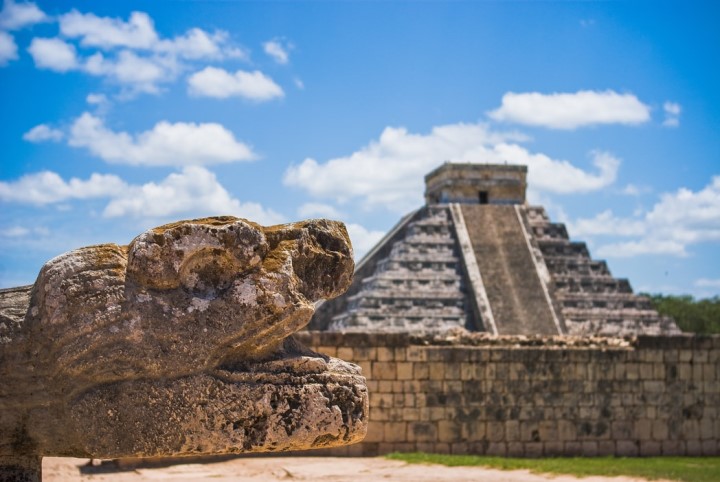Konuşarak Öğren'i Ücretsiz Deneyin
Chichen Itza is a city where the Maya people of Itza, which is a Mayan Indian community, lived. It is ocated in Yucatan, Mexico. The city is the country’s second most visited archaeological site. The historic city is visited by more than 2 million tourists a year. Cichen Itza means “In the Mouth of Itza”. The Pyramid of Kukulkan, also known as El Castillo in the city, was accepted as one of the Seven Wonders of the World chosen in 2007. The city is a settlement established before Christopher Columbus.
History of Chichen Itza
The Chichen Itza settlement began to occur between 750 and 900 AD. The last version of the settlement was shaped after 900 AD. From the 10th century onwards, the city was the capital city on a regional scale, ruled the northern shores of the center of Yucatan and extended its power to the east and west sides of the peninsula.
Chichen Itza was an important economic power in the region when it was active. Between 900 and 1050 AD, it was in a strong capital position, providing control in the northern and central regions of Yucatan. In addition, the design of the “time temples” in Chichen Itza, which attracts attention with its fascinating architecture, provides an understanding of the Mayan astronomical calendar.
Chichen Itza is located in Tinum Municipality in the eastern part of Yucaten state of the United States of Mexico, located in the southern half of the North American continent. It is 120 kilometers from Merida, the capital of Yucaten Province and the largest city of the Yucatan Peninsula.
Architectural Buildings in Chichen Itza
Kulkukan Temple
Kulkukan Pyramid is a laddered pyramid known as the “Castle”. This structure, built within a certain system, reveals the knowledge of the Mayans about astronomy and mathematics. There are 90 steps on four sides of the pyramid. When this number is multiplied by four and the flat area on the hill is added, the number of days in a year is 365. In addition, in the spring and autumn seasons, when the equinox occurs, the sun rays illuminating the pyramid form an S-shaped body at the snakes heads at the bottom of the stair steps from the protrusions of the pyramid. This two-headed snake is the feathered god snake called Kukulkan. In addition, the entire 300-hectare area, that is, all the buildings in the city can be seen easily by climbing on the top of the pyramid.
Caracol
Caracol, built in 906 AD, is an observatory where the Maya people follow the changes in the sky. Thanks to this structure, the people were able to freely watch the sky and get rid of the obstacles that the vegetation in the Yucatan Peninsula would be due to. There were 20 lines of sight in this observatory. Since some of the tower has disappeared, it is not possible to find other observation points.
Akab Dzib
Akab Dzib, means “House of Mysterious Writings” in Maya language. This building is the home of the director of Chichen Itza. Restoration of the building was completed in 2007. The building is 6 meters high, 50 meters long and 15 meters wide. The text that gives the building its name is on the southern end of the building.
Chichen Itza and the Gods
There is a victim well in Chichen Itza. Alive people were thrown into the victim’s well to please their Gods in times of drought. According to another view, young and beautiful virgin girls were thrown into the well together with their jewels to satisfy the Rain God.
On a 22,5 cm gold disc from this well, two armed Toltek warriors were painted attacking two Mayans trying to escape.
Since they thought that the Sun God Inti was fed with human blood, they were making ceremonies in Kukultan temple, removing the hearts of living people with knives made of obsidian and presenting them to their Gods. All these ceremonies, ball games, and details are depicted on the walls with reliefs.
Things To Know About Chichen Itza
- It is not allowed to climb the pyramid and swim in the cenotes.
- The temple is at the equinox of 20 March and 23 September where day and night are equal, the longest day is 21 June and the shortest day is 21 December, that is, in the summer and winter solstices, also on the start day of the Maya New Year, which is 16 July and the sun is at the peak of the world. Thanks to the interesting shadow games made by the steps in the body of the pyramid of the 2 snake’s heads at the bottom of the stairs, these snakes feel like they are alive.
- It is thought that the Maya did not use the wheel for the construction of their buildings.
- The land containing the ruins was a private land until it was acquired by Yucatan province on March 29, 2010.
- The two biggest sinkholes of the region in the city were also used for the storage of the water of the city and in the ceremonies for live human victims presented to the gods
- It is said that Chichen Itza is ruled by a multiple ruling group, not by a single king.
- It is assumed that the center was used for religious ceremonies, holy ball play and astronomical studies, except that the public did not enter.
- All the buildings of the city are connected to each other by stone paved roads called “White Road”.
Online İngilizce Konuşma Kursu: Konuşarak Öğren


